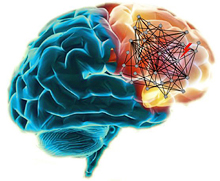Mutated Genes in Schizophrenia Map to Brain Networks
Mutated Genes in Schizophrenia Map to Brain Networks
Researchers found that people with schizophrenia have a high number of spontaneous mutations in genes that form a network in the front region of the brain. The findings reveal further clues about the causes of the disorder.

Schizophrenia networks in the prefrontal cortex area of the brain./Image courtesy of Dr. Mary-Claire King, University of Washington.
The disorder occurs in 1% of the general population. However, it occurs in 10% of people who have a parent, brother or sister with the disorder, indicating that genetics plays a role in its cause.
Previous studies have shown that many people with schizophrenia have de novo, or new, genetic mutations. These misspellings in a gene’s DNA sequence occur spontaneously and so aren’t shared by their close relatives.
Dr. Mary-Claire King of the University of Washington in Seattle and colleagues set out to identify spontaneous genetic mutations in people with schizophrenia and to assess where and when in the brain these misspelled genes are turned on, or expressed. The study was funded in part by NIH’s National Institute of Mental Health (NIMH). The results were published in the August 1, 2013, issue of Cell.
The researchers sequenced the exomes (protein-coding DNA regions) of 399 people—105 with schizophrenia plus their unaffected parents and siblings. Gene variations that were found in a person with schizophrenia but not in either parent were considered spontaneous.
The likelihood of having a spontaneous mutation was associated with the age of the father in both affected and unaffected siblings. Significantly more mutations were found in people whose fathers were 33-45 years at the time of conception compared to 19-28 years.
Among people with schizophrenia, the scientists identified 54 genes with spontaneous mutations predicted to cause damage to the function of the protein they encode. The researchers used newly available database resources that show where in the brain and when during development genes are expressed. The genes, they found, form an interconnected expression network with many more connections than that of the genes with spontaneous damaging mutations in unaffected siblings.
The spontaneously mutated genes in people with schizophrenia were expressed in the prefrontal cortex, a region in the front of the brain. The genes are known to be involved in important pathways in brain development. Fifty of these genes were active mainly during the period of fetal development.
“Processes critical for the brain’s development can be revealed by the mutations that disrupt them,” King says. “Mutations can lead to loss of integrity of a whole pathway, not just of a single gene.”
These findings support the concept that schizophrenia may result, in part, from disruptions in development in the prefrontal cortex during fetal development.
###
* The above story is reprinted from materials provided by National Institutes of Health (NIH)
** The National Institutes of Health (NIH) , a part of the U.S. Department of Health and Human Services, is the nation’s medical research agency—making important discoveries that improve health and save lives. The National Institutes of Health is made up of 27 different components called Institutes and Centers. Each has its own specific research agenda. All but three of these components receive their funding directly from Congress, and administrate their own budgets.



















